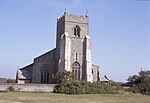Wiveton Downs
Geological Conservation Review sitesLocal Nature Reserves in NorfolkSites of Special Scientific Interest in Norfolk

Wiveton Downs is a 28.9-hectare (71-acre) biological and geological Site of Special Scientific Interest at Wiveton, west of Sheringham in the English county of Norfolk. Part of it is a Geological Conservation Review site, and an area of 6.5-hectare (16-acre) is a Local Nature Reserve. It is in the Norfolk Coast Area of Outstanding Natural Beauty.The site is a classic example of an esker, a glacial crevasse which has been filled in until it forms a narrow winding ridge. It is considered very important for teaching, research and demonstration.
Excerpt from the Wikipedia article Wiveton Downs (License: CC BY-SA 3.0, Authors, Images).Wiveton Downs
Langham Road, North Norfolk Blakeney
Geographical coordinates (GPS) Address Nearby Places Show on map
Geographical coordinates (GPS)
| Latitude | Longitude |
|---|---|
| N 52.944 ° | E 1.012 ° |
Address
Langham Road
Langham Road
NR25 7QS North Norfolk, Blakeney
England, United Kingdom
Open on Google Maps











